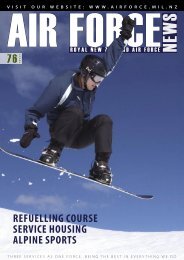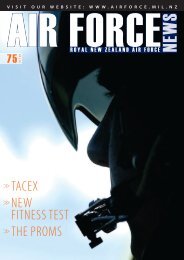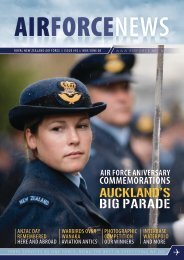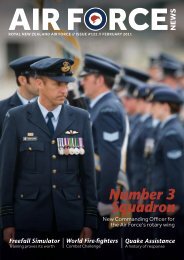June 2006, Issue 71 [pdf 2.8mb, 40 - Royal New Zealand Air Force
June 2006, Issue 71 [pdf 2.8mb, 40 - Royal New Zealand Air Force
June 2006, Issue 71 [pdf 2.8mb, 40 - Royal New Zealand Air Force
You also want an ePaper? Increase the reach of your titles
YUMPU automatically turns print PDFs into web optimized ePapers that Google loves.
A RNZAF C-130 Hercules makes a ponderous<br />
but safe landing on Bamian’s rough airfi eld.<br />
18<br />
AK 06-0147-06<br />
FAT ALBERT’S BAMIAN FORAY<br />
Flying the <strong>Air</strong> <strong>Force</strong>’s bulky C-130 Hercules,<br />
affectionately known as ‘Fat Albert’, into Afghanistan<br />
demands excellent training, full concentration and<br />
confidence in your abilities. But for No.<strong>40</strong> squadron<br />
flying into ‘difficult’ places is just part of normal<br />
operations. Pilot FLTLT Andy Scott describes the<br />
flight into Bamian airfield.<br />
The fl ight to Bamian takes just over 3.5 hours with the last 10 minutes<br />
being conducted at low level. This is obviously the portion that<br />
disturbs some of the passengers and has caused many of them<br />
to be sick over the course of these fl ights. So many that we do not keep<br />
track any more!<br />
On deciding whether or not to fl y low level, the crew will take into account<br />
the prevailing weather conditions, threat level, intelligence updates and<br />
common traffi c routing, before deciding which method of transit will be<br />
the safest for the day’s conditions. Contrary to popular belief the main<br />
purpose of fl ying low is not to make the passengers sick, but to provide<br />
the most tactically sound way of getting from A to B. When you’re the fat<br />
kid who is not very fast at running you have to learn to be sneaky to avoid<br />
getting caught!<br />
The crew’s initial Tactical Flying Qualifi cation is gained at Exercise<br />
Skytrain, with advanced tactics then honed on regular courses.<br />
The terrain around Bamian is up to 16,500ft, which can provide problems<br />
in inclement weather when trying to get below the cloud base safely. The<br />
main issue this has for us is the aircraft handling and performance characteristics.<br />
The altitude means that the true airspeed of the aircraft is a<br />
lot higher than normal so it takes a lot longer to slow the aircraft and the<br />
turning radius is a lot larger than it would be at sea level. This is something<br />
that could potentially catch out inexperienced pilots. We ensure all crews<br />
are fully briefed prior to departure. The temperature has a huge impact on<br />
C-130 operations out of Bamian also, as the heat of the summer means<br />
that the engines will only put out about 60% of their sea level power. This<br />
means that the payload we can carry out of Bamian in summer can be up<br />
to 10,000lb less than in winter.<br />
The threat of ground to air fi re is still a major issue with any fl ight into<br />
Afghanistan. There is still an enormous number of Man Portable Surface<br />
to <strong>Air</strong> Missiles (or MANPADS) unaccounted for in Afghanistan. The threat<br />
of one of these being used against an aircraft is still very real and so the<br />
aircraft is fi tted with Countermeasures, to combat this threat.<br />
The time spent on the ground can be anywhere from 15 minutes to 2<br />
hours depending on the amount of cargo we have to offl oad and timings<br />
for the next leg of the mission, as some airfi elds still have designated slot<br />
times that you have to arrive within.<br />
No fuel is available in Bamian so we often need to go to one of the<br />
main coalition bases to get a refuel before proceeding back to our<br />
staging base.<br />
The cargo we carry is in direct support of all NZDF missions in<br />
Afghanistan, so we carry everything from passengers to construction<br />
equipment to high explosives.<br />
AK 06-0147-23<br />
AK 06-0147-25<br />
AK 06-0147-07<br />
‘When you’re the fat kid who is not<br />
very fast at running you have to learn<br />
to be sneaky to avoid getting caught!’<br />
The actual runway at Bamian is very rough. It is a semi prepared gravel<br />
strip, however the size of the gravel and the amount the strip is prepared<br />
varies enormously along its length, with the fi rst and last 1000ft at each end<br />
being effectively unusable. This coupled with the large drop offs at each<br />
end and off each side, plus the proximity of houses and a small hill within<br />
75 ft of the centreline of the runway make it one of the more impressive<br />
places we land a C-130. A lot of damage has been done to the aircraft over<br />
AFN<strong>71</strong> JUNE 06 www.airforce.mil.nz



![February 2007, Issue 78 [pdf 3mb, 44 pages] - Royal New Zealand ...](https://img.yumpu.com/17485296/1/184x260/february-2007-issue-78-pdf-3mb-44-pages-royal-new-zealand-.jpg?quality=85)












